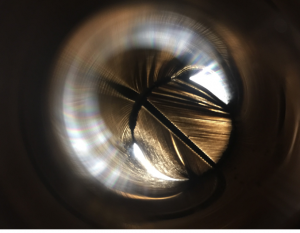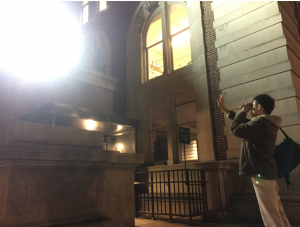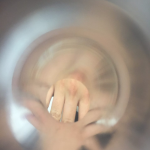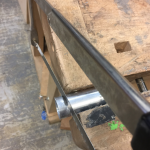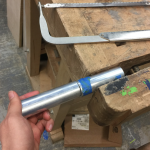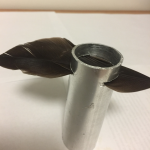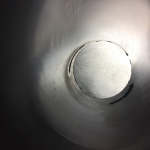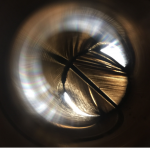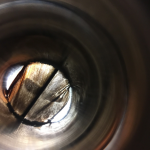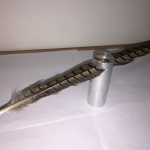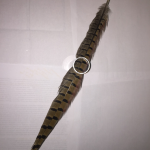by Jing Long Wee
This recipe is for a ‘simple and convenient X-ray tool’. The finished product is a metal tube through which one can supposedly ‘see’ into one’s skin and observe a pseudo-X-ray image of one’s hands and bones. This recipe first appeared in the 1912 Japanese publication, ‘Big Handbook for Boys and Young Men: A Brocade Bag of Knowledge’.
RECIPE: 軽便 X 光線器製法
ニッケル等の金属にては口径一寸弱長さ三寸位の円 筒を作り、両端に硝子を嵌め、一方の端より約三四 分の処へ鳥の羽毛(雉子の羽子最もよけれど、無く ば何鳥の毛でもよし)を挿入し置き、其筒を目にあ て、夜分灯光の傍にて手のひらまたは手指を透し見 るべし、骨部などありありと透見し得ること、実に 妙不可思議である。
Taken from Shōnen seinen daihōten: chishiki kinnō [Big Handbook for Boys and Young Men: A Brocade Bag of Knowledge]. Osaka: Shōbunkan, 1912: 50.
TRANSLATION: Making a simple and convenient X-ray tool:
Using a metal like nickel, make a cylinder with diameter not exceeding one sun (~ 3 cm), and an approximate length of three sun (~ 9 cm). Fit glass snugly into both ends. About three to four bun (~ 0.9-1.2 cm) away from one end of the cylinder, insert a bird feather (the feather of a Japanese pheasant, kiji, is most ideal, but if you don’t have that, the feather of any bird is fine too) into place. Line the cylinder up to your eye. Standing by the night lamp, you should see your palm and your fingers through the cylinder. It is really incredible to be able to get a clear peek into one’s bones.
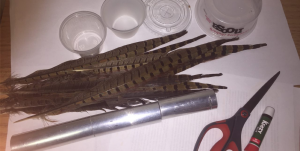 Though the recipe called for one to construct a cylindrical structure out of what is presumably a metal sheet (thereby suggesting that readers undertake the labour of rolling up and shaping the metal themselves), I chose to purchase a ready-made metal tube owing to my lack of experience in metal-working. I wonder if youths and (especially) younger boys in 1912 would have done the same? After all, that metal tubes were commonly used as piping material in everyday life (as mentioned in the ‘Tools & Equipment’ section) meant that youths could easily reuse old tubes or purchase new tubes in the marketplace — as long as the diameter of these tubes corresponded to that set out in the recipe.
Though the recipe called for one to construct a cylindrical structure out of what is presumably a metal sheet (thereby suggesting that readers undertake the labour of rolling up and shaping the metal themselves), I chose to purchase a ready-made metal tube owing to my lack of experience in metal-working. I wonder if youths and (especially) younger boys in 1912 would have done the same? After all, that metal tubes were commonly used as piping material in everyday life (as mentioned in the ‘Tools & Equipment’ section) meant that youths could easily reuse old tubes or purchase new tubes in the marketplace — as long as the diameter of these tubes corresponded to that set out in the recipe.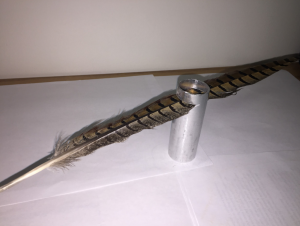 I found it puzzling that although the recipe had said that any metal was fine, it still recommended the use of nickel. Constrained by the fixed diameter of the tube set out in the recipe (~3cm), I could not find an appropriate ‘hollow nickel tube’ on Amazon. A trip to the nearby hardware store also turned up nothing.
I found it puzzling that although the recipe had said that any metal was fine, it still recommended the use of nickel. Constrained by the fixed diameter of the tube set out in the recipe (~3cm), I could not find an appropriate ‘hollow nickel tube’ on Amazon. A trip to the nearby hardware store also turned up nothing.
I found the purpose/use of glass to be unclear in the recipe. If the recipe was referring to clear glass, why was there a need for glass in the first place? After all, the perceptual experience looking through the tube with glass is same as that of looking through the tube without glass. What effect does the glass have? Does it entail a kind of ‘separation’ even as one is able to look through it, as Screech’s assigned chapter suggests? Yet what is the significance of this ‘separation’? Or is the glass not supposed to be clear? Does the glass interact with light in any way apart from letting light through?
Given that to ‘insert’ something is to put something into or through a ‘void’, i.e., an empty space., that the only ‘void’ available was the hollow within the metal tube, and that this hollow area was accessible only through the two ends of the tube (which was to be sealed), Could it be that the recipe mixed up the temporal sequence of required actions, and I was supposed to insert the feather through the ends of the tube? Using clear tape which allowed for easy disassembling I laid a feather parallel to the tube within the tube itself, taping it down 1 cm away from one end of the tube as per the recipe instructions, and looked through the tube. Interestingly, the feathers along the main spine of the feather caught and reflected more light from the surroundings than other parts. Orientating the feather this way, however, made it difficult to see through the finer structures of the feather, which now remained thoroughly opaque. Because of this, close to half of the view through the tube was severely obstructed by the feather. Admittedly, it was still possible to ‘see through’ the sections of the feather dangling outside of the tube, i.e., to render it more transparent, from certain angles like looking down from the highest point of the tube (though this would require the light source to be below the tube), or looking up from the lowest point of the tube. Given that the recipe stressed ‘seeing through’ the tube — and this implies the user’s line of sign running directly parallel to the length of the tube through the tube, however, this orientation of the feather seems unlikely.
For both street lamps, there was no observable difference (i.e., no shadow was cast) on the ‘feather’ if one did not look directly at a light source through a metal tube. ‘Shadows’ cast onto the feather under a more intense street lamp appear more clearly defined, darker compared with that under a less intense street lamp.
At certain angles from the light, the inner walls of the aluminium tube reflect and reproduce shadows of fingers and hands in such a way that these reflections merge with actual shadows cast onto the ‘feather’ to form thinner-looking fingers that are more similar to the X-ray image of hands obtained in 1896 (see previous section). At other angles from the light, instead, the inner walls of the tube reflect and reproduce shadows of fingers and hands in such a way that one’s fingers and hands appear broader than usual, contrary to what X-ray imaging produces. As such, the reflectivity/ shinniness of the inner walls of the aluminium tube does not necessarily contribute to the making of a more realistic ‘X-ray’ image.
Yet I wonder if it is right to definitively speak about what a more ‘realistic’ ‘X-ray’ image/ visual experience is, simply based on a few historical sources that I have dug up. Does the value of the ‘simple and convenient X-ray tool’ simply inhere within the boundaries of the sealed off metal tube (or at best, within the interactions between user, contraption and environmental light)? As I revisit photos taken by a friend that casts me (user) in a third-person light, I wonder if there is also a performative element in readers’ attempts to actually try out the completed ‘X-ray tool’ on the public streets at night.
Part of me felt embarrassed when testing out the tool at night in Columbia as I received quizzical stares from passing strangers and tourists. Who would have remained outside on the streets at night in Japan in the late 1800s and early 1900s? How might the act of playing around with and testing out the ‘tool’ be received by the larger public; what even is the ‘public’ here? Nonetheless, that my object looked really magical, mystical — given that a protruding long feather on a metal tube kind of calls to mind Harry Potter wands, and really quite absurd, paradoxically gave me the confidence to continue ‘playing’ with it in public. And in no time, one might actually say that I was actively seeking out and addressing the curious stares of passing strangers — gesturing and talking loudly to my friend to make clear to passers-by that we were conducting an ‘absurd’ experiment, i.e., that we were not doing anything questionable, but something ‘useful’, even though we really didn’t know how ‘useful’ exactly it is.
Subjective factors, e.g. how things smelled/tasted/looked/ felt; reflection on your
practice:The kinds of shadows that fell onto the feather as I held up a hand — this time, before a
street lamp that is significantly taller than the others I’ve experimented with — were no
different from the rest I’ve seen so far. It wasn’t more difficult to discern the ‘shadows’
cast by my hands and fingers. It appears that the intensity of the light source (which
clearly is affected by the distance from which one is away from the light source) — that is,
how brightly lit the feather is before any obstructions are placed before the tube, is a
more useful ‘factor’ in determining the experience one gathers through the tube. Similarly, the viewing experience of holding up the tube against a differently coloured
lamp was not very different. The only difference was that shadows were now cast
against a red ‘fluorescent’ background as opposed to a white background.
I tried using the tube against the flame of a scented candle in my room, and the
background was red as well. I wonder what colours private and public lighting in the late
1800s and early 1900s Japan predominantly took? Based on the early X-ray images I
stumbled upon — which were black-and- white, it would appear that using the ‘X-ray tool’
against a white lit background will produce effects closer to that of a ‘scientific’ X-ray
machine (comprising a vacuum tube or ionising tube among other materials). Was white
the colour of scientific objectivity back in the early 20th century? The orange and red
hues produced by red lamps and candle flames, however, engender a different kind of
affective experience that does not compromise the actual casting of ‘shadows’ onto the
feather. Perhaps conditioned by contemporary associations of colours, looking at red
and orange hues through the tube left me with a greater feeling of warmth.
Visually speaking, I also realised that a white fluorescent background draws more
attention to the actual structures, colours and patterns of the ‘intervening’ feather itself
(perhaps because we see most things under white light and so find objects to be most
familiar when they are lit up with white light at night). A red and orange fluorescent
background, on the other hand, projects a stranger image of the feather that we are less
used to. The pheasant feathers momentarily lose their ‘original’, ‘natural’ colours —
brown/blacks/whites are lost, and are saturated instead with reds and oranges, thereby
blending into the larger lit background of the night lamp. To this end, a red and orange
fluorescent background appears to have the effect of drawing attention away from and
concealing the presence of the ‘feather’ and its associated screening effects or
functions.
Questions that arise:
What was the general situation regarding lighting in Japan in the later 1800s and early 1900s? What kinds of private lighting were used during night time? How did these light sources compared with public street gas lamps? Which were brighter? Were there much traffic along the streets at night? These questions might lend greater clarity to the relatively obscure term used in the recipe — 夜分灯光, given that I have established that ‘shadows’ are formed more clearly against a more intense, i.e., brighter light source in the dark, and if we assume that the recipe really did aim to deliver sharp, crisp blackened bits projected onto the feather (as per ‘X-ray images’ published back then) for users’ viewing.
Does the value of the ‘simple and convenient X-ray tool’ simply inhere within the boundaries of the sealed off metal tube (or at best, within the interactions between user, contraption and environmental light), i.e., how ‘accurate’ does the image projected through the tube resemble that of X-ray imaging in the early 20th century?
Is there a performative element in readers’ attempts to actually try out the completed ‘X-ray tool’ on the public streets at night? Who would have remained outside on the streets at night in Japan in the late 1800s and early 1900s? How might the act of playing around with and testing out the ‘tool’ be received by the larger public; what even is the ‘public’ here?
Thoughts on some big questions from notes #4 & #5
11 March 2018
Larger question in the background: What are the politics surrounding making, if any?
Note #4 alerted me to the performative elements of the ‘recipe’ as I held the completed ‘X-ray
tool’ against public street lamps around Columbia. That experience also led me to ask how I
could be certain if the purpose of the recipe & the finished product only lay in their ability to give readers/ users a X-ray- like image, as per the standards of X-ray imaging back in the late 1800s
and 1900s, which closely resembles the idea of casting shadows onto a screen (as discussed in
review #1). Indeed, in review #1, I have focused primarily on drawing homological similarities
between the specific physical construction of 軽便X光線器 set out in the recipe and other set-
ups that were then commonly associated with the idea of X光線. I have also examined the
cultural meanings and ‘circulation stories’ (as opposed to origin stories) associated with each
material and with ‘X光線’ — both scientifically and figuratively, more broadly — hinting at perhaps
how the recipe is an assemblage that arose out of a specific time/ context.
Here, I wish to investigate not the direct effects of the completed product (i.e., asking questions
like how do I make the product work? What does it mean for the product to work?), but the
embodied/performative effects that the process of putting together the product gives rise to. Just
like how I am investigating the recipe to uncover tacit knowledge, and to play around with
uncertainty and ambiguity in order to understand the historical/ scientific contexts of Japan in
the 1910s (in the ethos of the Making & Knowing project), perhaps readers of the recipe in the
1910s were also not expected to create a fully functional product — indeed it seems impossible
that the simple set-up put forward by the recipe will ever produce scientific X-ray images. Did
the recipe then seek to impart common ideas and knowledge about ‘X-rays’ to readers not only
through a ‘close’ re-creation of an X-ray ‘shadow’ effect? — that is, ideas about ‘X-rays’ are not
just articulated through a completed product, but through the very process of making the
product. As discussed in review #1, specific mentions of nickel as the preferred metal arise out
of the indispensible nature of nickel in the production of vacuum tubes — then, the main source
through which X-rays are emmitted. By putting down ‘nickel’ onto the page, the author
articulates, although rather obliquely, to readers his knowledge about the close association
between nickel and X-rays. Should readers already be aware of this close association– as they
should be given explicit mentions of the mechanisms of X-rays and X-ray imaging in the
textbooks I have found in the early 20th century — the word ‘nickel’ prompts readers/users to
retrieve and revisit their memory of this association that now lay in the deep recesses of their
subconscious. Similarly, boys and youths who pick up the clear structural parallels in terms of
physical set-up between the supposed product of the recipe and conventional X-ray imaging
procedures as they are directly working on building the product as per the recipe, may refresh
old knowledge about X-rays, or pick up new insights about X-rays through the process. What I am getting at here returns to my initial hypothesis that this recipe serves as a heuristic tool,
albeit one that entails bodily labour, for readers and users to (re)visit ideas surrounding X光線.
Yet how do we situate the heuristic function of the recipe in historical context? Answering this
question would require us to think about the larger politics of ‘making’ in Japan. How do such
short amateur science recipes that hint at the notion of ‘X-rays’ rather indirectly for instance,
differ from longer textbook entries that directly describe factually what X-rays are and can do? In
the assigned journal article by Eugenia Lean, we see how knowing through ‘making’ —
constituted and suggested by the boom in recipes in female magazines, were valorised by some
nationalists as they processed their anxieties surrounding the stagnant state of China’s national
industry, and also the future of China. For many of these nationalists, republican China must
break away from the excessively intellectual (‘all say and theorising but no doing’) and abstract
mores and ways of living that dynastic China has been rooted on by focusing on ‘concrete’
things like ‘doing’. Here, we see how under changing political concerns, ‘making’ and knowing
through ‘doing’ — previously precisely the main labours of the artisan class that the ruling
scholar-class looked down at — now acquire potent symbolic and political value.
Mizuno’s “The Science Room as an Archive”
In his chapter (‘The science room as an archive: Taisho Japan and World War I’) in an edited
volume (The Decade of the Great War: Japan and the Wider World in the 1910s, published by
Brill in 2014), Hiromi Mizuno contextualises the rise of science rooms, or ‘science laboratories’
as we call them today, in some institutions in Japan in the 1910s against larger world
developments like the outbreak of WWI and the global circulation of ‘New Science Education
Ideals’. For starters, the outbreak of WWI in 1914 saw Japan unable to import crucial industrial
and pharmaceutical materials from Europe (e.g. metals like nickel), and this posed serious
challenge to a Japanese economy that relied heavily on Western products and resources
(Mizuno, p. 354). Consequently, ‘domestic production’ became a key phrase for solving the
immediate problems as well as for determining the future direction of Japan, and the Taishō
government — who considered science education crucial for this new direction, expanded the
science curriculum at elementary and middle school (Mizuno, p. 354). This shift toward a
greater emphasis of ‘science education’, however, is also heavily affected and shaped by the
New Science Education Movement that began to emerge in Japan in the early 1910s. As
Mizuno notes:
“Tanahashi Gentarō’s 1913 publication, Science Education Pedagogy [Sh in rika kyōjuhō], is considered the pivotal text in the movement. Tanahashi wasa great advocate of Henry Armstrong’s ‘heuristic method’ (translated to‘discovery method’ in Japanese) — which emphasised the importance ofgiving an opportunity for children to ‘discover’ o n their own through direct observation and experimentation.” (Mizuno, p. 352)
Indeed, the New Science Education Movement in Japan in the 1910s — when the recipe was
published — saw “students’ direct experience with natural phenomena, rather than memorization
of the textbook or passive observation of the teacher’s demonstration as the key to a truly scientific education” (Mizuno, p. 353). For these activists, science was not about an efficient
accumulation of scientific facts in the student’s brain. It was meant to be a more holistic,
fundamental education to create a thinking person with the independent, scientific, and civic
mind (Mizuno, p. 353). Crucially, in Japan, for many advocates ot the movement, “the ultimate
objective of the New Science Education Movement was to nurture the scientific spirit among the
Japanese people, as a critical challenge to the Meiji curricula by the authoritarian, bureaucratic
state and its militarism” (Mizuno, p. 353-4).
Taken together, Mizuno’s account points to a greater emphasis on a more experimental and
liberal approach to scientific knowing within the government (admittedly to a limited extent) and
grassroots forces in the new Taishō period beginning in 1912 and proceeding throughout the
1910s and 1920s before ultra-right militarism (re)emerged in the 1930s. This is the result of the
Meiji-Taishō transition in 1912 which finally allowed for the masses to react against the
conservatism of the previous Meiji period, the rise of New Science Education movement within
Japan from 1913, and the outbreak of WW1 in 1914.
Mizuno critically notes that “while it is understandable that child-centered learning and self-
discovery were meant to challenge the more authoritarian style of textbook memorization,
conducting experiments as told by teachers does not inherently entail an exercise a critical mind
or democratic politics’ (Mizuno p. 368). Against this, one may argue that ‘non-science- related’
publications and recipes like the ones I have selected — insofar as they are more readily
assessible in the commercial realm of popular consumption and insofar as they encourage the
pursuit of knowledge and self-exploration in a broader way while still retaining associations with
objective ‘science’– better exemplifies the ethos that New Science Education movement
advocates sought to promote.
Against the context in the 1910s that Mizuno sets up for us, we might understand the 1915
reprinting, refashioning and reappropriation of the publication and its recipes — this time under
the auspices of government-linked organisation ‘Imperial Publishing House for Boys’ (Teikoku
shōnen shōin), as an attempt by the state and its related organs to promote national self-
sufficiency, by encouraging ceaseless self-disciplining through the endless pursuit of knowledge
amongst young boys and men, in light of trade disruptions brough forth by the outbreak of
WW1. Editors’ 1915 decision to keep relatively un-scientific ‘scientific’ recipes (like the ‘X-ray’
machine) while removing recipes or how-tos that have to do with ‘magic’ (majutsu) in this
edition, suggest that while the Taishō government has broadened its understanding of valuable
scientific kowledge — from one that exclusively took the form of a rote memorization of scientific
facts, to one that is constituted by bodily encounters with scientific principles, i.e., knowing
through ‘doing’, ‘thinking’ and ‘playing’ — they continue to draw a strict line between non-
scientific and scientific knowledge, useful and non-useful knowledge.
In contrast, the greater mish-mash of recipes in the original 1912 publication suggests a greater
acceptance of the plurality of legitimate epistemologies. Drawing on superstition, common
sense, popular wisdom, canonised mythologies and classical literature, and dealing with a
broad range of topics, the knowledge put forth in the original 1912 volume is expansive, yet ultimately ‘disciplined’ insofar as it is reduced on paper to mere texts (i.e., explicit/ explicable
knowledge) and carefully curated to fit the limited and finite form of an encyclopaedia. It is
wrong to claim, I think, that the ‘making’ that my selected recipe encourages amongst readers is
solely the result of Taishō Japan aiming for a more experimental and hands-on approach to
scientific knowledge in order to strengthen the Japanese nation and its subjects. Indeed, we are
always ‘making’ and knowing through ‘making’ (i.e., in tacit ways). Perhaps it is the boom in
publishing of popular and fun guidebooks like my selected publication, during the more liberal
later-Meiji and early Taishō democratic period, that made it easier for these tacit forms of
knowing to be represented textually — thereby becoming ‘explicit’, and capable of being
circulated. Under this materialist view, the ‘knowing through‘making’ or heuristic value of my
selected recipe may not so much be attributed to a change in larger political attitudes (i.e., is not
the result of a normative leaning or a change in human sentiment — eschewing a human-
centered history), but to the rise of material forms that are efficacious in mediating the interface
between tacit & explicit knowledge, between the performative quality of written text (i.e., to elicit certain behavioral shifts, to allow one to retrieve one’s memory of scientific theories that they
have read in more objective textbooks, to encourage one to ‘play’ around with and entertain the
multiplicity of cultural and philosophical meanings associated with each material and the overall
process) and the constantive quality of written text (i.e., what is literally written on the text).
What comes out of this exercise then, is the re-realisation that although ‘making’ and ‘knowing
through making’ comes in and out of fashion whether because non-human material or
anthropocentric factors renders them representable and therefore visible and transmittable,
‘making’ and ‘knowing through making’ have always been around. Given this, one might situate
the whole Making & Knowing project in its historical context. What exactly lay behind scholars’ contemporary fixation on ‘knowing through making’, on phenomenological and embodied
effects? In other words, why has ‘knowing through making’ become fashionable today (again)?
In this project to move beyond the textual, the visual, the ideological and to enter the sensorial,
the embodied, and the affective, what kind of pasts do scholars construct? — one that (reads
past scholarship in a simple and narrow way to precisely) present(s) (selective) past scholarship
as simplistic and narrow? What kind of futurities, if any, are we aiming at? Are we at risk of
overemphasing the newness of ‘knowing through making’, and falling into the trap of framing
history as progressivist?
